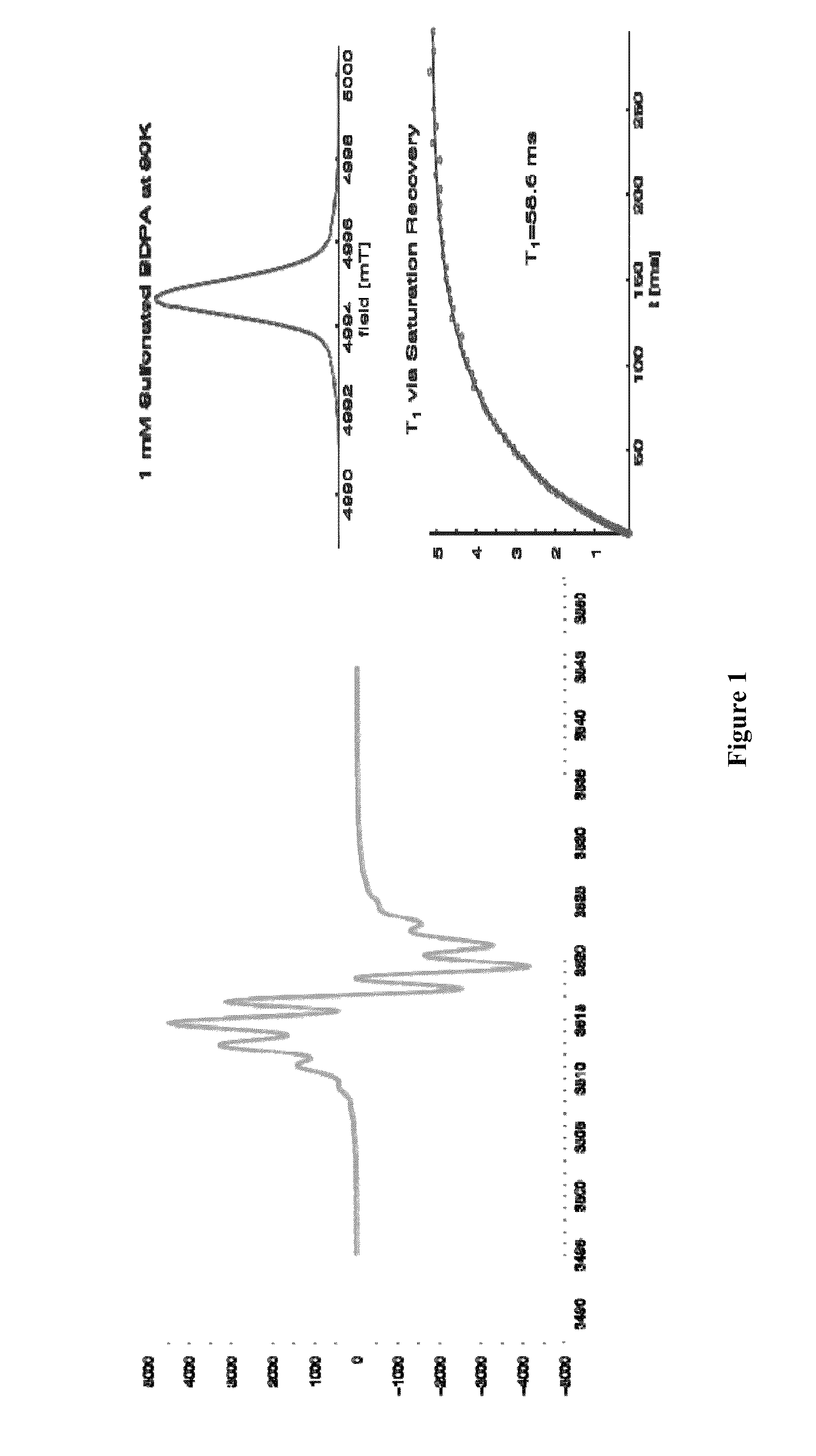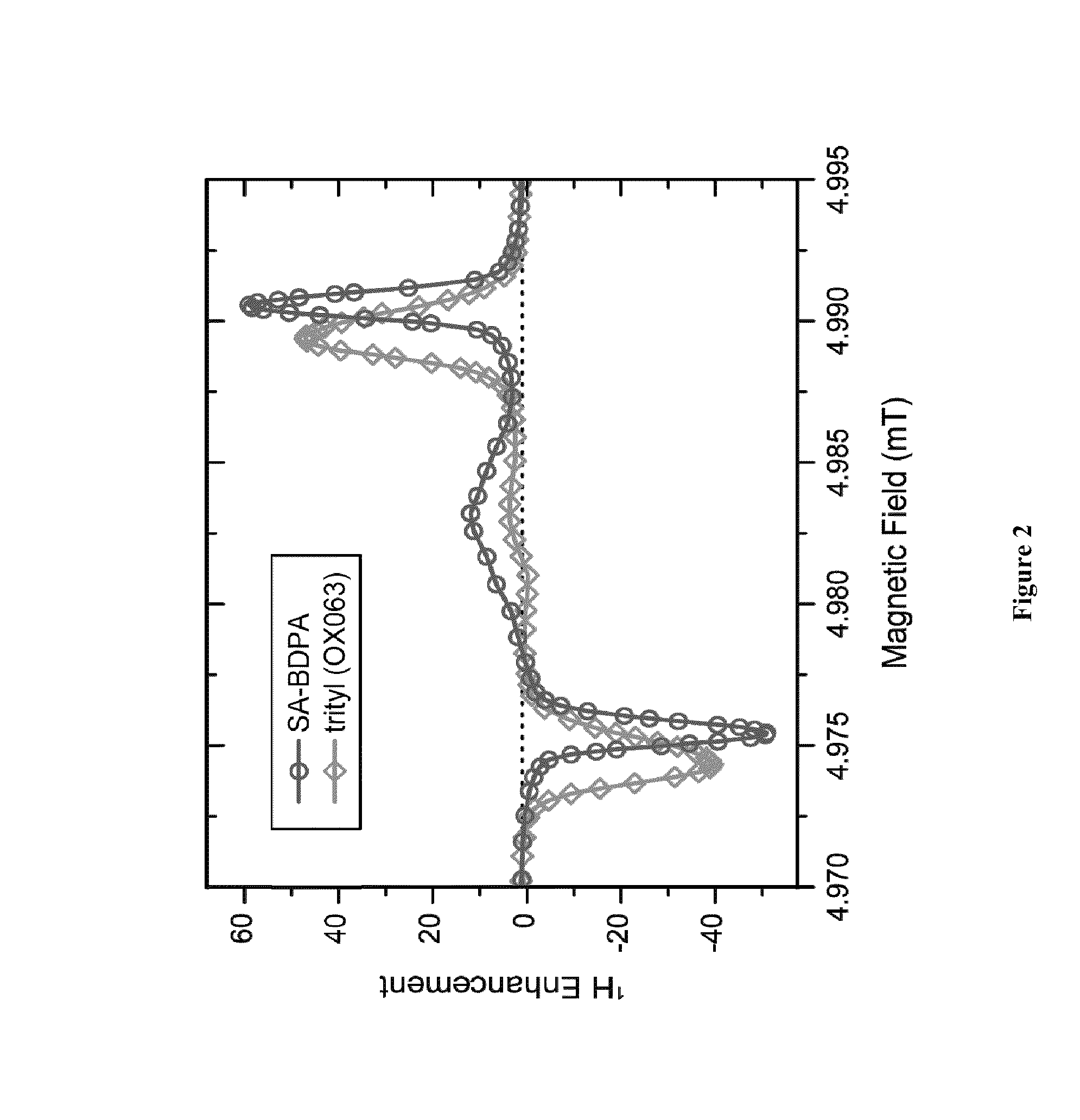Radical polarizing agents for dynamic nuclear polarization
a nuclear polarization and radio polarization technology, applied in the field of radio polarizing agents for dynamic nuclear polarization, can solve the problems of limiting their usefulness in aqueous systems, and recent attempts to produce water-soluble radicals with suitable properties for dnp have limited success
- Summary
- Abstract
- Description
- Claims
- Application Information
AI Technical Summary
Benefits of technology
Problems solved by technology
Method used
Image
Examples
example 1
Synthesis of Sulfonated BDPA
[0132]BDPA is an air stable persistent radical that shows no dimerization in solid or in solution. BDPA has an extremely narrow EPR linewidth (Δ=20 MHz at 140 GHz), and can be used for OE and SE and TM DNP NMR. While BDPA is an excellent polarization agent, its utility in biological applications is limited by lack of solubility in aqueous media.
[0133]
[0134]Synthesis of SA-BDPA (2a) was accomplished by treating BDPAH (4) with fuming sulfuric acid followed by deprotonation and oxidation (Scheme 2). BDPAH can be prepared in 4 steps from commercially available materials.
[0135]Specifically, 100 mg (0.239 mmol, 1 equiv) of BDPAH (4) and 1 mL fuming sulfuric acid were heated at 85° C. while stirring for 5 min. The resulting brown solution was carefully diluted with 20 mL of deionized water and the resulting salmon-colored solution stirred at room temperature for 16 h and was filtered to remove any insoluble material. The filtrate was treated with 16 mL of 10% Na...
example 2
Synthesis of Sulfonated DPPH
[0138]Reactions with sulfuric acid and chlorosulfonic acid, followed by hydrolysis of the resulting sulfonyl chloride, can be used to generate a variety of water soluble stable radicals starting from the non-water soluble precursors. Preliminary results show that DPPH can be reacted with chlorosulfonic acid to generate a water soluble radical after hydrolysis.
[0139]
example 3
Synthesis of Sulfonated / Sulfonamidated BDPA
[0140]Reaction of BDPAH derivatives (5) with chlorosulfonic acid produces chlorosulfonates (6), which can be hydrolyzed or reacted with a variety of amines prior to oxidation to give both ionic and neutral polarization agents.
[0141]
[0142]Where Z═COOH, reaction of HOOC-BDPAH (5) with chlorosulfonic acid produces chlorosulfonate 6 which can be hydrolyzed or reacted with a variety of amines prior to oxidation to give both ionic and neutral polarization agents. For example, treatment of 6 with sodium hydroxide in water followed by AgNO3 oxidation and cation exchange gave 7—a highly water-soluble ionic radical similar to SA-BDPA (FIG. 5). Replacing NaOH with diethanolamine gave a neutral radical 6.
PUM
| Property | Measurement | Unit |
|---|---|---|
| frequency | aaaaa | aaaaa |
| atomic number | aaaaa | aaaaa |
| Larmor frequency | aaaaa | aaaaa |
Abstract
Description
Claims
Application Information
 Login to View More
Login to View More - R&D
- Intellectual Property
- Life Sciences
- Materials
- Tech Scout
- Unparalleled Data Quality
- Higher Quality Content
- 60% Fewer Hallucinations
Browse by: Latest US Patents, China's latest patents, Technical Efficacy Thesaurus, Application Domain, Technology Topic, Popular Technical Reports.
© 2025 PatSnap. All rights reserved.Legal|Privacy policy|Modern Slavery Act Transparency Statement|Sitemap|About US| Contact US: help@patsnap.com



